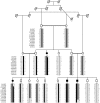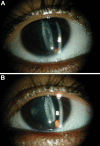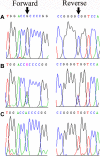Autosomal recessive congenital cataract linked to EPHA2 in a consanguineous Pakistani family
- PMID: 20361013
- PMCID: PMC2846848
Autosomal recessive congenital cataract linked to EPHA2 in a consanguineous Pakistani family
Abstract
Purpose: To investigate the genetic basis of autosomal recessive congenital cataracts in a consanguineous Pakistani family.
Methods: All affected individuals underwent a detailed ophthalmological and clinical examination. Blood samples were collected and genomic DNAs were extracted. A genome-wide scan was performed with polymorphic microsatellite markers. Logarithm of odds (LOD) scores were calculated, and Eph-receptor type-A2 (EPHA2), residing in the critical interval, was sequenced bidirectionally.
Results: The clinical and ophthalmological examinations suggested that all affected individuals have nuclear cataracts. Genome-wide linkage analyses localized the critical interval to a 20.78 cM (15.08 Mb) interval on chromosome 1p, with a maximum two-point LOD score of 5.21 at theta=0. Sequencing of EPHA2 residing in the critical interval identified a missense mutation: c.2353G>A, which results in an alanine to threonine substitution (p.A785T).
Conclusions: Here, we report for the first time a missense mutation in EPHA2 associated with autosomal recessive congenital cataracts.
Figures




References
-
- Robinson GC, Jan JE, Kinnis C. Congenital ocular blindness in children, 1945 to 1984. Am J Dis Child. 1987;141:1321–4. - PubMed
-
- Hejtmancik JF, Smaoui N. Molecular genetics of cataract. Dev Ophthalmol. 2003;37:67–82. - PubMed
-
- Foster A, Johnson GJ. Magnitude and causes of blindness in the developing world. Int Ophthalmol. 1990;14:135–40. - PubMed
-
- Butt T, Yao W, Kaul H, Xiaodong J, Gradstein L, Zhang Y, Husnain T, Riazuddin S, Hejtmancik JF, Riazuddin SA. Localization of autosomal recessive congenital cataracts in consanguineous Pakistani families to a new locus on chromosome 1p. Mol Vis. 2007;13:1635–40. - PubMed
Publication types
MeSH terms
Substances
LinkOut - more resources
Full Text Sources
Medical
Miscellaneous
